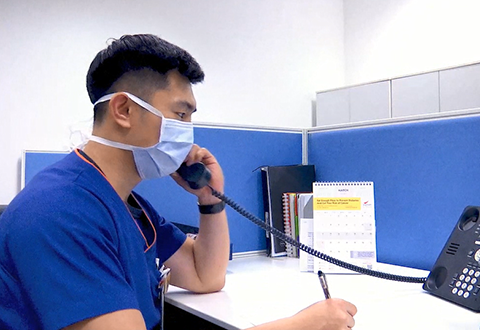
When face-to-face medication reconciliation is not possbile, Pharmacists will contact patients via other means such as phone calls, to seek clarifications.
Medication reconciliation sounds like a big word but it is in fact, an important process performed by Pharmacists to enhance patient safety. Simply put, medication reconciliation is an activity where Pharmacist compares a patient’s current list of medications against the medications found on his electronic medical records, with the aim of producing a complete and accurate medication list.
In conjunction with Pharmacy Week 2021 organised by Pharmaceutical Society of Singapore (PSS), medication reconciliation service was offered free to the community to raise awareness on the roles of pharmacists in patient care and the importance of monitoring one’s own medications.

Information on medication reconciliation was shared on NHCS Facebook as well.
At NHCS, medication reconciliation is done at both the inpatient and outpatient settings. For the former, it is usually performed within 24 hours upon admission to ensure all medications are ordered appropriately, even for medications that the patient was taking prior to admission. “This allows the primary care team to review the medications that could have precipitated the health events of the patient and allow for optimisation of therapy,” shared Chan Hong, Pharmacist, who added that medication reconciliation is also done at every visit to the pharmacy.
Challenges of medication reconciliation
Teo Siew Chong, Assistant Director, Pharmacy shared, “Medication reconciliation can be a complex process depending on each patient’s situation. For example, some patients who visit multiple different institutions for their treatments may end up confused about their medications prescribed. When we attempt to interview or seek clarifications, patients may not even recognise the medication they are taking or recall the dosage.”
“At times, the patient’s various healthcare providers may also make dose adjustments and when this happens, we will have to contact them for medication records and reconciliation to get complete list of medications and its dosages that the patient is actually taking,” said Chan Hong.
Benefits to patients
A key benefit of medication reconciliation is it helps to prevent medication errors which could have resulted from unintended omissions or changes in treatment plan.
“By consolidating the medications for the patient, the medication list serves as a communication tool to the care team to avoid therapeutic duplications or interactions, and helps in optimising treatment plans. For instance, the care team may choose a long-acting version of a drug which patient just needs to take once a day as opposed to a short-acting one which needs to be consumed twice daily,” Chan Hong explained.
Individuals can also take ownership of their medications to better the medication reconciliation experience. Siew Chong advised, “We can keep a simple record of our own medications, including the supplements and vitamins we are taking and show them at the doctor’s visit. This will help smoothen the process and keep us safe.”













 Get it on Google Play
Get it on Google Play